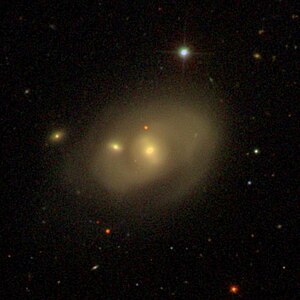NGC 4795
| Galaxy NGC 4795 |
|
|---|---|

|
|
| SDSS recording | |
| AladinLite | |
| Constellation | Virgin |
|
Position equinox : J2000.0 , epoch : J2000.0 |
|
| Right ascension | 12 h 55 m 02.8 s |
| declination | + 08 ° 03 ′ 56 ″ |
| Appearance | |
| Morphological type | (R ') SB (r) a / pec: |
| Brightness (visual) | 12.2 mag |
| Brightness (B-band) | 13.1 mag |
| Angular expansion | 2.3 ′ × 1.6 ′ |
| Position angle | 118 ° |
| Surface brightness | 13.5 mag / arcmin² |
| Physical data | |
| Redshift | 0.009276 +/- 0.000020 |
| Radial velocity | 2781 +/- 6 km / s |
|
Stroke distance v rad / H 0 |
(122 ± 8) · 10 6 ly (37.4 ± 2.6) Mpc |
| history | |
| discovery | Wilhelm Herschel |
| Discovery date | January 23, 1784 |
| Catalog names | |
| NGC 4795 • UGC 8037 • PGC 43998 • CGCG 043-064 • MCG + 01-33-024 • 2MASX J12550289 + 0803555 • GC 3302 • H II 21 • h 1474 • LDCE 0920 NED002 | |
NGC 4795 is a 12.2 likes bright barred spiral galaxy of Hubble type SBa in the constellation Virgo . It is an estimated 122 million light-years away from the Milky Way and has a diameter of around 90,000 ly. It is connected to NGC 4796 by gravity , and its eastern arm is already showing signs of this influence.
The object was discovered on January 23, 1784 by Wilhelm Herschel with an 18.7-inch reflector telescope, who described it as “pretty bright, pretty large, brighter towards the preceding side”.
